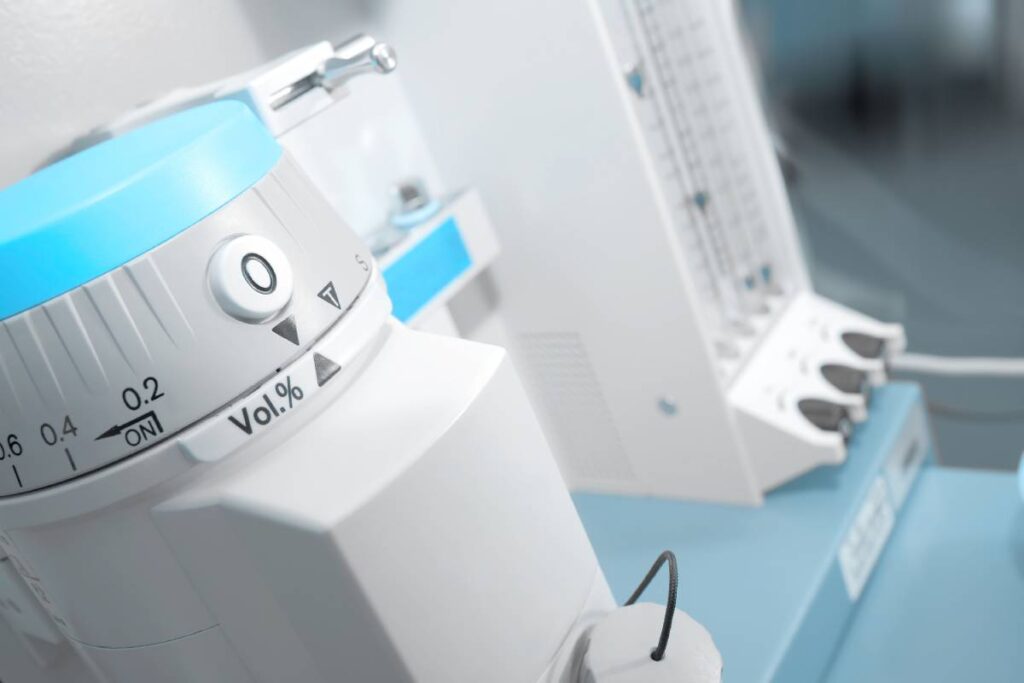Inhaled volatile anesthetics are the most widely used drugs for the maintenance of general anesthesia thanks to their easy administration and predictable intraoperative and recovery characteristics. Modern inhalation anesthetics that are predominantly used in clinical practice include gaseous (nitrous oxide) and volatile liquid agents, including desflurane and isoflurane.
Desflurane is similar to isoflurane in its provision of anesthesia for intubation and maintenance [1]. A study assessing thirty-two patients who received general anesthesia for lengthy orthopedic procedures found no significant difference between desflurane and isoflurane as regards intubating conditions or blood pressure or heart rate in response to tracheal intubation. Both are also highly similar in their interaction with pancuronium [1].
Both also have advantages over other volatile anesthetics. In light of the low blood-gas partition coefficients of isoflurane (1.4) and desflurane (0.42), both desflurane and isoflurane result in a more rapid emergence from anesthesia than with traditional inhalation anesthetics.
However, desflurane is faster acting than isoflurane, resulting in faster emergence and recovery [2]. A meta-analysis found that patients receiving desflurane were able to follow commands a mean of 4.4 minutes more rapidly after surgery than patients receiving isoflurane [3]. Another study focused on healthy patients scheduled for routine surgeries confirmed that there were significant differences between desflurane and isoflurane groups. Recovery of patients from anesthesia was swifter in the desflurane group, and its patients were more alert than those of the isoflurane group [4]. However, the efficient use of isoflurane may, in certain cases, match the speed of induction and recovery of desflurane [5].
Desflurane tends to increase heart rate and occasionally cause a hyperdynamic response during rapid deepening of anesthesia [1]. A study sought to compare the hemodynamic, emergence, and recovery characteristics of isoflurane with those of desflurane in individuals receiving general anesthesia for pelviabdominal operations. Ninety American Society of Anesthesiologists (ASA) class I patients between 15 and 50 years of age scheduled for elective abdominal or pelvic surgeries were enrolled, and patients were randomly allocated into one of two groups slated to receive either desflurane or isoflurane. Postoperative complications and depth of anesthesia, as assessed from the bispectral index, revealed no significant differences between the study groups. However, in terms of recovery characteristics, desflurane was more rapidly cleared from the body. This study’s results indicate that desflurane has better recovery characteristics and hemodynamic parameters than isoflurane in patients undergoing elective pelviabdominal operations [6]. Additional studies can inform anesthesia providers whether this pattern continues for other surgeries or patient groups.
Research has shown that desflurane tends to allow faster recovery after anesthesia than isoflurane. However, and perhaps related to this, desflurane has been found to be less potent than isoflurane [2].
A number of factors should be considered when selecting the right anesthetic. Patient characteristics, type of breathing system, type and length of the procedure, and efficiency in patient monitoring must be taken into account when choosing the best anesthetic on a case-by-case basis [5].
Maximizing the clinical advantages of these anesthetic agents while minimizing operational and financial waste requires an understanding of their characteristics, pharmacodynamics, and pharmacokinetics. An anesthetic agent algorithm may, too, be used for the decision process of selecting between desflurane and isoflurane [5].
References
- Azad, S. S. et al. A comparison of desflurane and isoflurane in prolonged surgery. J. Clin. Anesth. 5, 122–128 (1993). doi: 10.1016/0952-8180(93)90139-6.
- Comparing the use of inhalation anaesthetics – The Pharmaceutical Journal. Available at: https://pharmaceutical-journal.com/article/research/comparing-the-use-of-inhalation-anaesthetics#fn_1. (Accessed: 24th February 2023)
- Dexter, F. & Tinker, J. H. Comparisons between Desflurane and Isoflurane or Propofol on Time to Following Commands and Time to DischargeA Metaanalysis. Anesthesiology 83, 77–82. (1995). doi: 10.1097/00000542-199507000-00009.
- Mallik, T., Aneja, S., Tope, R. & Muralidhar, V. A randomized prospective study of desflurane versus isoflurane in minimal flow anesthesia using “equilibration time” as the change-over point to minimal flow. J. Anaesthesiol. Clin. Pharmacol. 28, 470 (2012). doi: 10.4103/0970-9185.101916
- Sakai, E. M., Connolly, L. A. & Klauck, J. A. Inhalation anesthesiology and volatile liquid anesthetics: focus on isoflurane, desflurane, and sevoflurane. Pharmacotherapy 25, 1773–1788 (2005). doi: 10.1592/phco.2005.25.12.1773.
- Shoukry, A. A., Laltif, A. A., Fattah, A. A., Ghani, I. A. & Serag, M. Isoflurane versus desflurane: hemodynamic parameters and recovery characteristics: a comparative study. Ain-Shams J. Anaesthesiol. 9, 45 (2016). doi: 10.4103/1687-7934.178879

